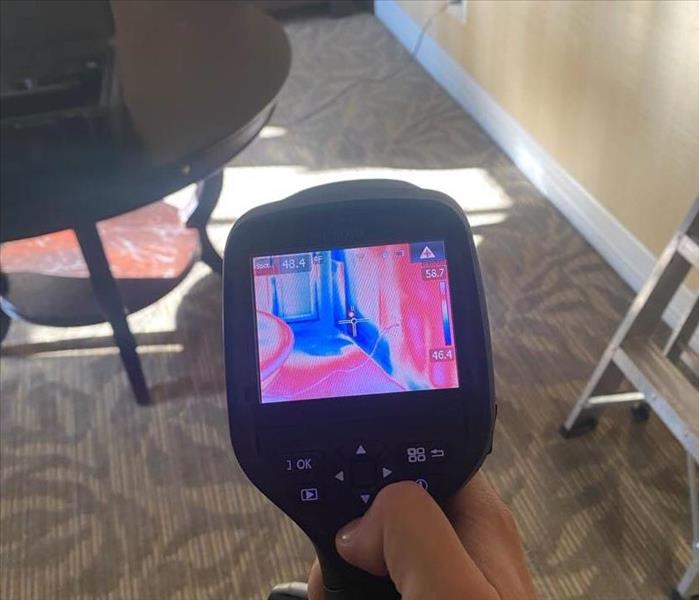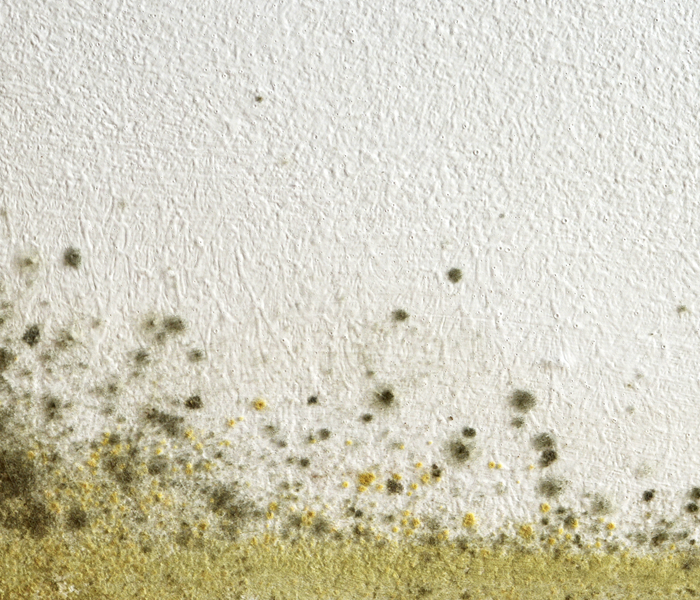Archived Mold Remediation Blog Posts
Protecting Your Home & Health: Mold Prevention and Restoration
3/26/2025 (Permalink)
We know mold concerns can be unsettling, affecting your comfort, health, and peace of mind. Preventing mold growth is essential to maintaining a safe, healthy home environment.
Routine checks for moisture issues can make a significant difference. Inspect common problem areas such as laundry rooms, under sinks, near windows, and around air conditioners. Using exhaust fans during showers and cooking, quickly repairing leaks, and maintaining appropriate indoor humidity levels are simple yet effective strategies to keep mold away.
However, if mold is already a problem, addressing it quickly is crucial. SERVPRO of Northwest Phoenix/Anthem provides professional mold restoration with genuine care and understanding. Our trained specialists utilize safe, effective mold remediation techniques to fully restore your home. We understand your concerns and ensure the restoration process causes minimal disruption to your daily life.
Trust us to handle your mold concerns professionally and empathetically. SERVPRO of Northwest Phoenix/Anthem is committed to helping you reclaim your home, restoring your comfort, and protecting your family's health from mold issues.
Contact us (623) 780-9111
Mold in Carpets: How to Remove and Prevent It
3/13/2024 (Permalink)
 Mold found in carpets can result in unpleasant odors and discoloration. In this blog, we will explore tips and steps for removing and preventing mold.
Mold found in carpets can result in unpleasant odors and discoloration. In this blog, we will explore tips and steps for removing and preventing mold.
Carpets are an attractive and comfortable flooring option, but they can also be susceptible to mold growth. Mold damage to carpets can occur due to various reasons, such as exposure to moisture, spills, and leaks. Mold found in carpets can result in unpleasant odors, discoloration, and even damage to the fibers. In this blog, we will explore tips and steps for removing and preventing mold in carpets.
Identifying the Mold in Carpets
Mold damage to carpets can be hard to detect, especially in the early stages. Some signs of mold in carpets include:
- Musty odors
- Discoloration of the carpet fibers
- Stains or discoloration on the carpet backing
- Water damage or stains on the walls or ceiling near the carpet
- The presence of mold or moisture elsewhere in the room or home
Steps for Removing Mold from Carpets
If you suspect mold damage in your carpets, it is crucial to address it promptly to prevent further contamination. Here are the recommended steps for removing mold from carpets:
- Personal Protective Equipment: Wear proper personal protective equipment, such as gloves and a respirator, during the mold remediation process.
- Isolation of the Affected Area: Isolate the affected area to prevent the spread of mold spores. Close off the area to other parts of the house and use plastic sheeting to create a barrier.
- Remove Any Excess Water: Dry the carpet as quickly as possible to prevent further mold growth. Remove any excess water using a wet/dry vacuum or absorbent towels.
- Apply Mold Cleaning Agent: Apply a mold cleaning agent to the carpet using a spray bottle or fogging machine. Allow the cleaning agent to sit for the recommended amount of time.
- Clean the Carpet: Clean the carpet thoroughly using a hot water extractor or steam cleaner. Ensure that all cleaning solution and moisture have been extracted from the carpet.
- Dispose of Any Contaminated Items: If any items, such as padding or carpeting, are too contaminated or damaged to be salvaged, dispose of them properly.
Tips for Preventing Mold in Carpets
Prevention is key to avoiding mold damage to carpets. Here are some tips to prevent mold growth in your carpets:
- Address Water Damage Promptly: If any water damage occurs, address it promptly to prevent excess moisture buildup and mold growth.
- Maintain Proper Ventilation in Your Home: Proper ventilation helps with moisture control, reducing the risk of mold growth.
- Use a Dehumidifier: Use a dehumidifier to reduce excess moisture in the air and maintain an optimal humidity level of around 50 percent.
- Clean and Dry Spills Promptly: Clean up any spills promptly to prevent them from seeping into the carpet fibers and creating a moisture source for mold growth.
- Regularly Clean Your Carpets: Regular carpet cleaning helps remove any dirt and moisture that can contribute to mold growth and prolongs the life of your carpet.
- Have Your Carpets Inspected and Cleaned Professionally: Regular professional inspection and cleaning help identify any potential mold issues and address them promptly before they escalate.
Mold damage in carpets can be unpleasant and harmful if left unaddressed. Identifying the mold, prompt removal, and prevention are crucial steps to keeping your carpets clean and mold-free. Follow the tips and recommendations provided above to remove mold damage from carpets and prevent future contamination. Consider seeking the services of a professional mold remediation team if the mold damage is extensive or if you are unsure of how to handle the remediation process. By taking these steps, you can ensure a mold-free and healthy living environment.
How To Remove Mold Smell In Your Home
11/9/2023 (Permalink)
 If you ever encounter mold problems beyond your control, our local SERVPRO® of Northwest Phoenix/Anthem team is here to assist you!
If you ever encounter mold problems beyond your control, our local SERVPRO® of Northwest Phoenix/Anthem team is here to assist you!
While our city boasts sunny days and a dry climate, mold can still find its way into our homes, often accompanied by musty and unpleasant odors. In this blog, your local SERVPRO® team will guide you through the process of identifying and eliminating moldy smells in your Phoenix home.
Understanding the Moldy Odor
Moldy odors are often the first sign of a hidden mold problem. Even in our arid desert environment, moisture can accumulate in the nooks and crannies of our homes, providing the ideal conditions for mold growth. Identifying and addressing these odors promptly can help maintain a fresh and welcoming living space.
Identifying Moldy Odors
Musty or Earthy Smell: Mold often emits a musty, earthy odor. It's a distinctive smell that can be particularly strong in areas with active mold growth.
Damp or Stale Odor: Moldy odors are often associated with dampness and staleness. If you notice these odors in specific areas of your home, it's essential to investigate further.
Localized Odors: Moldy smells are typically localized to areas with moisture issues or poor ventilation. Common problem areas include bathrooms, kitchens, and crawl spaces.
Eliminating Moldy Smells
Locate the Source
Start by identifying the source of the odor. Inspect areas with suspected mold growth or moisture problems. Look for visible signs of mold, such as discolored patches or fuzzy growth. Sometimes, mold can hide behind walls or under flooring.
Address Moisture Issues
Mold thrives in damp conditions. Ensure that your home is free from leaks, water intrusion, or plumbing issues that may be contributing to the moisture problem. Properly ventilate high-humidity areas like bathrooms and kitchens to prevent moisture buildup.
Clean and Remove Mold
If you find mold, it's crucial to clean and remove it promptly. Use appropriate cleaning products and follow safety guidelines. For extensive or hidden mold problems, consider professional mold remediation services from SERVPRO® to ensure thorough removal.
Use Air Purifiers
Air purifiers with HEPA filters can help remove mold spores and odors from the air, improving indoor air quality.
Deodorize Effectively
Use natural deodorizers like baking soda, activated charcoal, or vinegar to absorb and neutralize odors. Place them in affected areas or use them as part of your cleaning routine.
Identifying and eliminating moldy smells is essential for a pleasant and healthy home environment in Phoenix. By addressing moisture issues, locating the source of the odor, and taking appropriate remediation steps, you can maintain a fresh and odor-free living space. If you ever encounter mold problems beyond your control, our local SERVPRO® of Northwest Phoenix/Anthem team is here to assist you with professional mold remediation services. Stay odor-free and enjoy a comfortable living environment in the Valley of the Sun!
Understanding Mold Removal: How Long Does It Typically Take?
5/22/2023 (Permalink)
 Understanding mold removal is important to ensure your property is protected from mold damage.
Understanding mold removal is important to ensure your property is protected from mold damage.
Mold is a common problem in many homes, and it's important to address it promptly to prevent further damage to your home. If you have mold in your home, you may be wondering how long it will take to remove it. In this blog, we will explore the factors that can impact the length of time it takes to remove mold from your home.
Factors Affecting Mold Removal Time
The length of time it takes to remove mold from your home can vary depending on several factors.
The size and extent of the mold infestation will impact how long it takes to remove the mold. If the mold is limited to a small area, it may only take a few days to remove. However, if the mold has spread to multiple areas of your home or if there is a large amount of mold present, it may take longer to remove.
Type of Mold
Different types of mold require different removal methods, and some types of mold are more difficult to remove than others. For example, black mold can be particularly difficult to remove and may require more extensive remediation measures.
Remediation Methods
The methods used to remove the mold will impact how long it takes to complete the remediation process. For example, if the mold is removed using traditional methods such as scrubbing and cleaning, it may take longer than if more advanced methods such as dry ice blasting or ozone treatment are used.
Environmental Factors
Environmental factors such as temperature and humidity can impact the length of time it takes to remove mold. Higher temperatures and humidity levels can promote the growth of mold, which can make the removal process take longer.
Accessibility
The accessibility of the mold can impact how long it takes to remove it. If the mold is in hard-to-reach areas, it may take longer to remove.
How Long Does Mold Removal Typically Take?
The length of time it takes to remove mold from your home will vary depending on the factors outlined above. In general, mold removal can take anywhere from a few days to several weeks. However, it's important to note that the length of time it takes to remove the mold is less important than ensuring that the mold is completely removed.
Mold removal professionals typically follow a specific process to remove mold from your home assessing the extent of the mold infestation.
Containing the mold to prevent it from spreading
Removing the mold using appropriate methods
Cleaning and disinfecting the affected areas
Conducting post-remediation testing to ensure that all mold has been removed
Mold removal is an important process that should be taken seriously to prevent further damage to your home. The length of time it takes to remove mold from your home will vary depending on several factors, including the size and scope of the infestation, the type of mold, the remediation methods used, environmental factors, and accessibility. It's important to work with a qualified mold removal professional to ensure that the mold is completely removed and that your home is safe for you and your family.




 24/7 Emergency Service
24/7 Emergency Service


